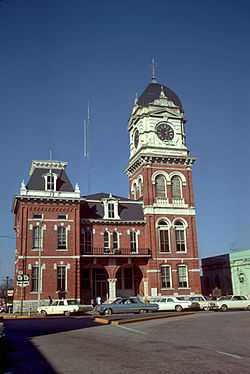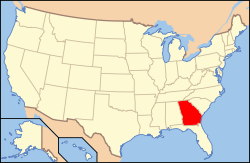Newton County, Georgia
| Newton County, Georgia | |
|---|---|
 Newton County courthouse in Covington | |
 Location in the state of Georgia | |
 Georgia's location in the U.S. | |
| Founded | November 30, 1821 |
| Named for | John Newton |
| Seat | Covington |
| Largest city | Covington |
| Area | |
| • Total | 279 sq mi (723 km2) |
| • Land | 272 sq mi (704 km2) |
| • Water | 7.0 sq mi (18 km2), 2.5% |
| Population | |
| • (2010) | 99,958 |
| • Density | 367/sq mi (142/km²) |
| Congressional districts | 4th, 10th |
| Time zone | Eastern: UTC-5/-4 |
| Website |
www |
Newton County is a county located in the U.S. state of Georgia. As of the 2010 census, the population was 99,958.[1] The county seat is Covington.[2]
Newton County is included in the Atlanta-Sandy Springs-Roswell, GA Metropolitan Statistical Area.
History
Newton county is named after Sgt. John Newton, who served under Gen. Francis Marion, the "Swamp Fox", in the American Revolutionary War. It was created on December 24, 1821. During the American Civil War, the county provided the Lamar Infantry, which was a part of Cobb's Legion. Georgia is one of many states which have a Newton County and a Jasper County that border each other.
In late 1978, the first five episodes of The Dukes of Hazzard were filmed in and around Covington, Georgia. The TV series In The Heat of the Night was filmed in Covington from 1988 to 1995. Also, in Remember the Titans, there were many scenes shot on "The Square" and the final football scene in was shot at Homer Sharp Stadium, which is located right off "The Square" in downtown Covington. Currently part of the new series The Vampire Diaries is being fiimed on the Square. Additionally, major films including My Cousin Vinny, Friday the 13th Part VI: Jason Lives and Halloween II, Rob Zombie's sequel to his 2007 film Halloween, were also filmed near and around "The Square" in downtown Covington.
Newton county claims to be the birthplace of Georgia 4-H. Actually, the Girls Canning and Boys Corn Clubs in 1904 by G.C. Adams was renamed the 4-H Club in 1906, after the original 4-H Club that opened in Iowa in 1905.
Geography
According to the U.S. Census Bureau, the county has a total area of 279 square miles (720 km2), of which 272 square miles (700 km2) is land and 7.0 square miles (18 km2) (2.5%) is water.[3]
Major highways
-
 Interstate 20
Interstate 20 -
 U.S. Route 278
U.S. Route 278 -
 State Route 11
State Route 11 -
 State Route 12
State Route 12 -
 State Route 20
State Route 20 -
 State Route 36
State Route 36 -
 State Route 81
State Route 81 -
 State Route 138
State Route 138 -
 State Route 142
State Route 142 -
 State Route 162
State Route 162 -
 State Route 162 Connector
State Route 162 Connector -
 State Route 212
State Route 212 -
 State Route 402 (unsigned designation for I-20)
State Route 402 (unsigned designation for I-20)
Adjacent counties
- Walton County (north)
- Morgan County (east)
- Jasper County (southeast)
- Butts County (south)
- Henry County (southwest)
- Rockdale County (northwest)
Demographics
| Historical population | |||
|---|---|---|---|
| Census | Pop. | %± | |
| 1830 | 11,155 | — | |
| 1840 | 11,628 | 4.2% | |
| 1850 | 13,296 | 14.3% | |
| 1860 | 14,320 | 7.7% | |
| 1870 | 14,615 | 2.1% | |
| 1880 | 13,623 | −6.8% | |
| 1890 | 14,310 | 5.0% | |
| 1900 | 16,734 | 16.9% | |
| 1910 | 18,449 | 10.2% | |
| 1920 | 21,680 | 17.5% | |
| 1930 | 17,290 | −20.2% | |
| 1940 | 18,576 | 7.4% | |
| 1950 | 20,185 | 8.7% | |
| 1960 | 20,999 | 4.0% | |
| 1970 | 26,282 | 25.2% | |
| 1980 | 34,489 | 31.2% | |
| 1990 | 41,808 | 21.2% | |
| 2000 | 62,001 | 48.3% | |
| 2010 | 99,958 | 61.2% | |
| Est. 2013 | 102,446 | 2.5% | |
As of the census[8] of 2000, there were 62,001 people, 21,997 households, and 17,113 families residing in the county. The population density was 224 people per square mile (87/km²). There were 23,033 housing units at an average density of 83 per square mile (32/km²). The racial makeup of the county was 55.27% White, 45.21% Black or African American, 0.22% Native American, 0.72% Asian, 0.02% Pacific Islander, 0.58% from other races, and 0.98% from two or more races. 1.87% of the population were Hispanic or Latino of any race.
There were 21,997 households out of which 37.70% had children under the age of 18 living with them, 59.20% were married couples living together, 14.10% had a female householder with no husband present, and 22.20% were non-families. 18.30% of all households were made up of individuals and 6.60% had someone living alone who was 65 years of age or older. The average household size was 2.77 and the average family size was 3.14.
In the county the population was spread out with 27.70% under the age of 18, 8.90% from 18 to 24, 32.10% from 25 to 44, 21.50% from 45 to 64, and 9.90% who were 65 years of age or older. The median age was 33 years. For every 100 females there were 94.70 males. For every 100 females age 18 and over, there were 90.20 males.
The median income for a household in the county was $44,875, and the median income for a family was $49,748. Males had a median income of $36,742 versus $26,097 for females. The per capita income for the county was $19,317. About 7.20% of families and 10.00% of the population were below the poverty line, including 14.90% of those under age 18 and 8.80% of those age 65 or over.
Education
Communities
See also
References
- ↑ 1.0 1.1 "State & County QuickFacts". United States Census Bureau. Retrieved June 24, 2014.
- ↑ "Find a County". National Association of Counties. Retrieved 2011-06-07.
- ↑ "US Gazetteer files: 2010, 2000, and 1990". United States Census Bureau. 2011-02-12. Retrieved 2011-04-23.
- ↑ "U.S. Decennial Census". United States Census Bureau. Retrieved June 24, 2014.
- ↑ "Historical Census Browser". University of Virginia Library. Retrieved June 24, 2014.
- ↑ "Population of Counties by Decennial Census: 1900 to 1990". United States Census Bureau. Retrieved June 24, 2014.
- ↑ "Census 2000 PHC-T-4. Ranking Tables for Counties: 1990 and 2000" (PDF). United States Census Bureau. Retrieved June 24, 2014.
- ↑ "American FactFinder". United States Census Bureau. Retrieved 2011-05-14.
External links
- Covington and Newton County Living
- The City of Covington official site
- Downtown Covington
- The Covington/Newton County Chamber of Commerce
- The Center for Community Preservation and Planning
- The Covington News
- The Newton Citizen
Coordinates: 33°35′57″N 83°51′31″W / 33.599243°N 83.858729°W
 |
Rockdale County | Walton County |  | |
| |
Morgan County | |||
| ||||
| | ||||
| Henry County | Butts County | Jasper County |
| |||||||||||||||||||||||||
| |||||||||||||||||||||||||||||||||||||||||||||||||
